Built upon Lake Texcoco, thousands of people flocked to the Great Pyramid. The inauguration of the latest reconstruction by Ahuitzotl occurred in the year 8 Reed (1487). Warrior after warrior captured in the Flower War climbed to the top to be sacrificied to the gods. Tlaloc and Huitzilopochtli would be pleased with their followers; blood flowed like a river down the endless staircase. But this was not the final bloodshed - the Spaniards were coming.
Tenochtitlan began as a tiny marsh island in Lake Texcoco and was surrounded by chinampas - an agricultural system created by layering mud and vegetation in shallow parts of lakes. The city was connected to the mainland by three large causeways, which served as dikes - separating the city's freshwater from the surrounding salty waters. Chinampa canals helped convey traffic around the city.
It wasn't until the 1900s when the temple was found in ruins. A waterway built tore through the site destroying even more of Mexico's ancient history. Mexico was well aware of the existence of the Great Pyramid; the Catedral Metropolitana (Metropolitan Cathedral) was purposely built on top of the site to enforce Catholicism on the Aztec people. The site visible today was excavated after in 1978.
Today the Templo Mayor is open to the public. Much of its majesty and mystery remains buried at the heart of the Zocalo.
Taking that first step into the ruins sends you almost a thousand years back in time. Modern elevated paths take you through the site through its many phases of construction. What are these phases?
Each ruler of Tenochtitlan was responsible for enlarging or expanding the Great Pyramid. Not only did the expansions reflect the growing population but may have been motivated by the constant floods the city suffered. These stages of construction are visible "thanks to" the conquest when the city was destroyed.
"Tenochtitlan." Columbia Encyclopedia. The Columbia Electronic Encyclopedia, Sixth Edition. Copyright © 2012, Columbia University Press. Licensed from Columbia University Press. All rights reserved. www.cc.columbia.edu/cu/cup/.
 |
| Scale model of the Great Pyramid at Tenochtitlan previously located at Templo Mayor museum. Currently on display at the Zocalo Metro Station. [Wikipedia/Wolfgang Sauber CC-SA-3.0] |
.jpg/569px-Codex_Magliabechiano_(141_cropped).jpg) |
| Aztec ritual human sacrifice portrayed in the page 141 (folio 70r) of the Codex Magliabechiano. [Wikipedia/Public Domain] |
Flower Wars :: name given to the the battles fought between the city-states of the Triple Alliance: Tenochtitlan, Texcoco, Tlalcopan, and Huejotzingo. These ritual battles began during the reign of Moctezuma I when a great famine struck the land. Though many interpretations of the Flower Wars exist, the most popular idea is that these wars were a special institutionalized type of warfare used to satisfy the religious needs of the combatants. The warriors captured were honorably sacrificed for the good and welfare of their nation.Many are familiar with the Aztec empire that flourished from 1325-1519, until the conquest led by Hernan Cortes. Their great capital, Tenochtitlan, was made possible by the cultural unity and political power of their time. But how is a city built on a lake?
Tenochtitlan began as a tiny marsh island in Lake Texcoco and was surrounded by chinampas - an agricultural system created by layering mud and vegetation in shallow parts of lakes. The city was connected to the mainland by three large causeways, which served as dikes - separating the city's freshwater from the surrounding salty waters. Chinampa canals helped convey traffic around the city.
 |
Chinampa model at the Templo Mayor Museum
© Melanie Magdalena
|
Discovery
It wasn't until the 1900s when the temple was found in ruins. A waterway built tore through the site destroying even more of Mexico's ancient history. Mexico was well aware of the existence of the Great Pyramid; the Catedral Metropolitana (Metropolitan Cathedral) was purposely built on top of the site to enforce Catholicism on the Aztec people. The site visible today was excavated after in 1978.
 |
| Waterway constructed under the street Guatemala in the 1900s © Melanie Magdalena |
Understanding the Ruins
Today the Templo Mayor is open to the public. Much of its majesty and mystery remains buried at the heart of the Zocalo.
Taking that first step into the ruins sends you almost a thousand years back in time. Modern elevated paths take you through the site through its many phases of construction. What are these phases?
 |
| Templo Mayor cut-out. The ruins today are visible inside. © Melanie Magdalena |
Each ruler of Tenochtitlan was responsible for enlarging or expanding the Great Pyramid. Not only did the expansions reflect the growing population but may have been motivated by the constant floods the city suffered. These stages of construction are visible "thanks to" the conquest when the city was destroyed.
Destruction of the Great Pyramid of Tenochtitlan
Tenochtitlan fell in 1521 and was almost completely destroyed. The Avila brothers, the conquerors, built their homes on top of the ruins. The brothers and Martin Cortes, son of Hernan Cortes, were arrested and sentenced to death in 1566 for conspiring against the Spanish crown.For Further Viewing
Please visit our Google Plus album to view all of our photos of Templo Mayor taken during the MexiArch Project :: View album>>
MexiArch Project photos by Melanie E Magdalena are licensed under a Creative Commons Attribution-NonCommercial-ShareAlike 3.0 Unported License. Permissions beyond the scope of this license may be available. Contact editor@bermudaquest.com for commercial permission.
For Further Reading
This article is part of the MexiArch Project (2012) by BermudaQuest










